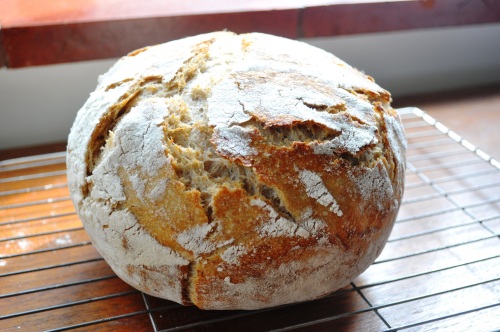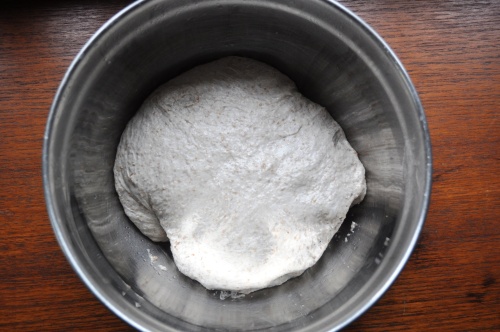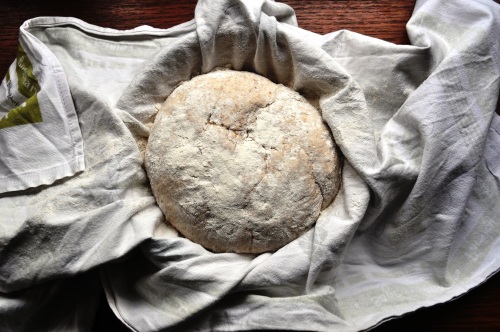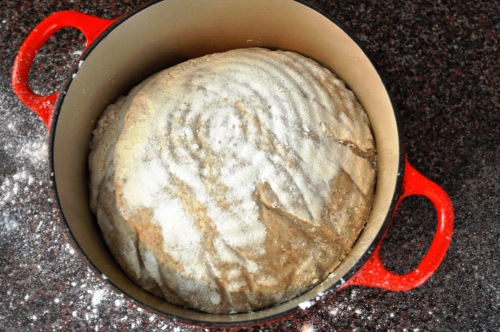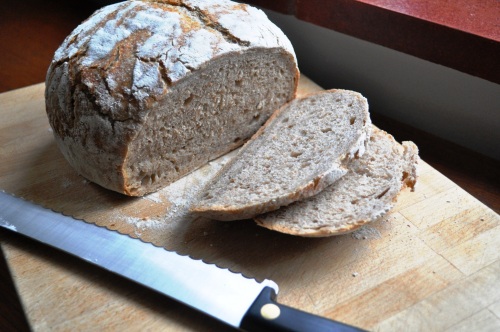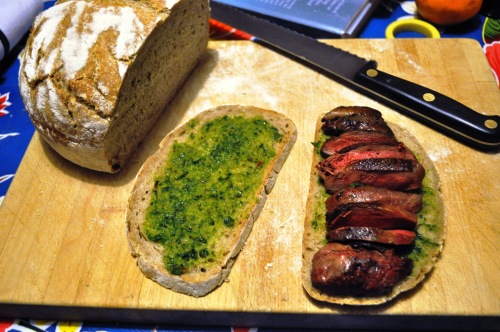Purists will disdain it, but I’ve not got a problem with using a combination of sourdough starter and commercial yeast. This is semi-sourdough baking. The sourdough gives some depth of flavour while the addition of the yeast helps a baker of my middling ability to control the timings better.
It’s a technique I learned from the essential book The Handmade Loaf by Dan Lepard. It’s a technique that stands me in good stead as, honestly, I never mastered getting satisfactorily consistent sourdough loaves. I probably could master it if I had a real push but it’s not really where I’m at these days. Indeed, mostly I just make a fairly basic tin loaf these days for toast, something my family Hoovers at breakfast time. It involves yeast and a mixture of stoneground strong white and wholemeal wheat and spelt flours.
When I want something a bit more interesting, I reach for the sourdough. This is what I’ve been making recently. It involves the no-knead and Dutch oven techniques. The latter means baking it in a preheated Dutch oven, cast iron casserole dish or even a terracotta chicken brick. I’ve got one called a knuspertopf, my mum’s got one called a römertopf. My German-speaking father tells me topf means pot, while knusprig means crisp or crunchy. Römer means Roman, apparently. They all work well, retaining the moisture, adding some steam to the bake.
Combine to make a preferment
100g of sourdough starter at 100% hydration (ie, refreshing it with equal quantities water and flour)
2g active dried yeast or 4g fresh yeast
100g stoneground wholemeal wheat flour
100g water
I don’t worry about the temperature of the water. Leave this mixture at room temperature (about 19C in our place now) for about 6-8 hours. One good option is to make it at lunchtime.
After the allotted time, when the preferment is bubbling nicely, make the dough by adding
500g flour (I used a 50/50 mix of stoneground white wheat and wholemeal wheat)
400g water
7g fine sea salt
1. Just beat it all together until it clears, that is, until the flour is fully mixed with the water and there are no dry bits left. It’ll be a sloppy, wet dough. For those interested in bakers’ percentages, this works out at about 85% hydration. Ie, the total flour comes to 650g, the total water comes to 550g; 550/650 x 100 = 84.61.
2. Cover the bowl; I use a floral shower cap but a plastic bag is fine. Leave the dough for about 12 hours. I’ve been putting it in the fridge for about 10 of that. Overnight is good.
3. Remove the dough from the fridge and allow it to come back to room temperature. I’m not sure how important this is and haven’t scientifically investigated it yet. Some suggest a cold dough is good for oven spring, but I’m not convinced about that, it’d just be a sluggish spring.
4. Set your oven to maximum. Sadly, my electric Rangemaster only musters about 220C, at best. Put your chosen casserole dish in and heat it up for about 20-30 minutes.
5. Using a dough scraper, carefully remove the dough from the bowl onto a floured worktop. Handling it gently so as not to deflate it or damage it structure too much, fold one side into the middle, then the other, like a letter, to form a rough loaf shape.
6. Take the hot, hot dish out of the oven, remove its lid and, gently as you can, er, drop the dough into it. Put the lid back on, put it in the oven and bake for about 40 minutes.
7. Turn the oven down to 180C and bake for another 10 minutes.
8. Take the dish out, turn out the loaf, then return it to the oven for another 10 minutes. One risk with a dough this wet is that it may not cook all the way through. It should do with the preheated dish and a baking time this long but if you’re not sure, over-baking won’t do too much harm, other than thickening the crust a bit.
9. Remove from the oven and cool on a wire rack.
Now, this is a pretty easy way to make fairly satisfying loaf. It’s got a good chewy crust and a reasonably open crumb structure. My only criticism is that it can feel slightly rubbery, if that makes sense. It’s definitely worth a try though, for that artisan vibe, and it makes cracking toast. Even if kids do fuss about the crust. Honestly, some mornings it feels like all I eat for breakfast is rejected crusts…





